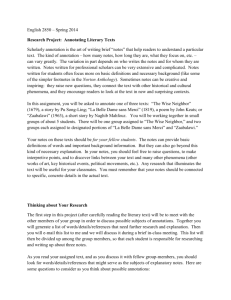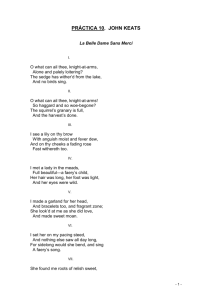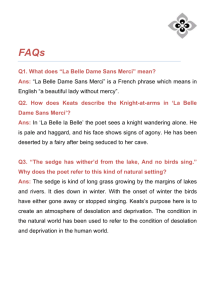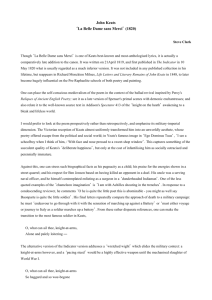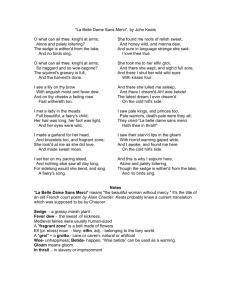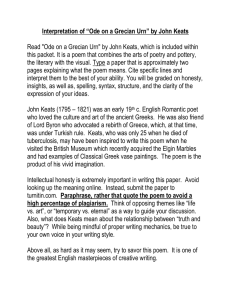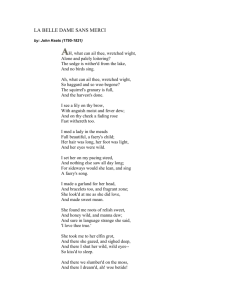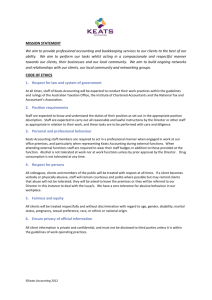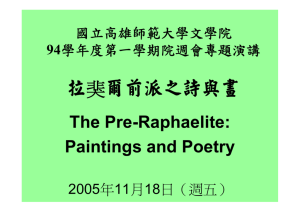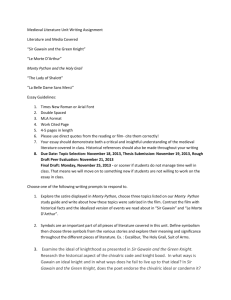Keats and the Painters
advertisement
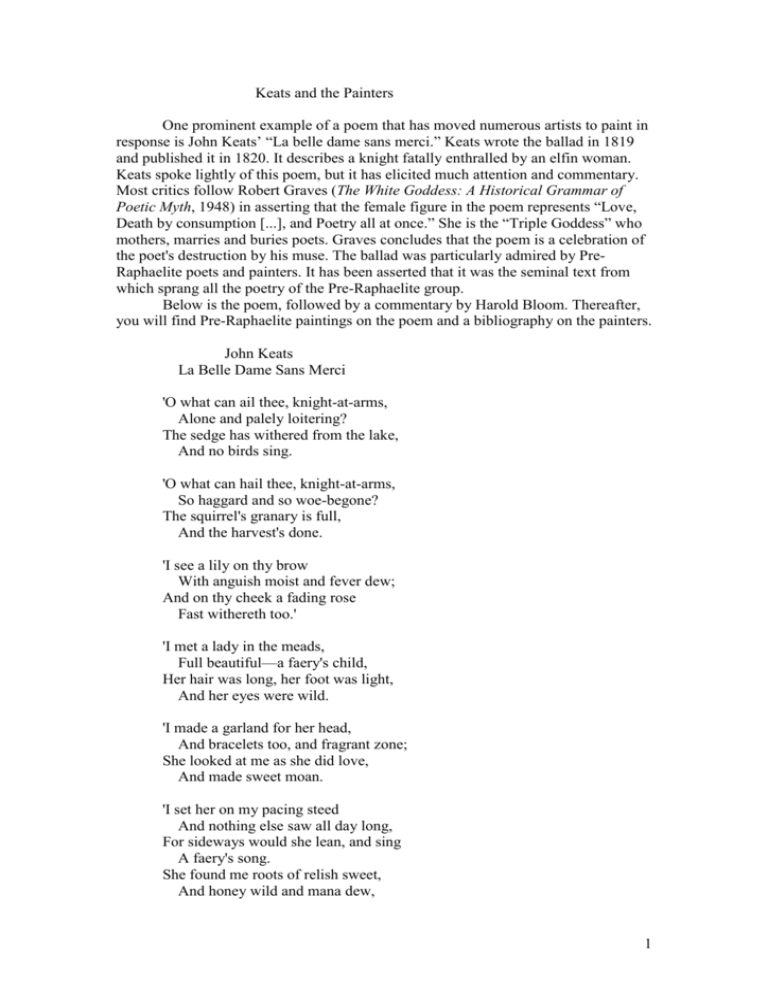
Keats and the Painters One prominent example of a poem that has moved numerous artists to paint in response is John Keats’ “La belle dame sans merci.” Keats wrote the ballad in 1819 and published it in 1820. It describes a knight fatally enthralled by an elfin woman. Keats spoke lightly of this poem, but it has elicited much attention and commentary. Most critics follow Robert Graves (The White Goddess: A Historical Grammar of Poetic Myth, 1948) in asserting that the female figure in the poem represents “Love, Death by consumption [...], and Poetry all at once.” She is the “Triple Goddess” who mothers, marries and buries poets. Graves concludes that the poem is a celebration of the poet's destruction by his muse. The ballad was particularly admired by PreRaphaelite poets and painters. It has been asserted that it was the seminal text from which sprang all the poetry of the Pre-Raphaelite group. Below is the poem, followed by a commentary by Harold Bloom. Thereafter, you will find Pre-Raphaelite paintings on the poem and a bibliography on the painters. John Keats La Belle Dame Sans Merci 'O what can ail thee, knight-at-arms, Alone and palely loitering? The sedge has withered from the lake, And no birds sing. 'O what can hail thee, knight-at-arms, So haggard and so woe-begone? The squirrel's granary is full, And the harvest's done. 'I see a lily on thy brow With anguish moist and fever dew; And on thy cheek a fading rose Fast withereth too.' 'I met a lady in the meads, Full beautiful—a faery's child, Her hair was long, her foot was light, And her eyes were wild. 'I made a garland for her head, And bracelets too, and fragrant zone; She looked at me as she did love, And made sweet moan. 'I set her on my pacing steed And nothing else saw all day long, For sideways would she lean, and sing A faery's song. She found me roots of relish sweet, And honey wild and mana dew, 1 And sure in language strange she said, “I love thee true!” She took me to her elfin grot, And there she wept and sighed full sore; And there I shut her wild, wild eyes With kisses four. 'And there she lullèd me asleep, And there I dreamed—Ah woe betide! The latest dream I ever dreamed On the cold hill's side. 'I saw pale kings and princes too, Pale warriors, death-pale were they all; Who cried—“La belle Dame sans Merci” Hath thee in thrall!” 'I saw their starved lips in the gloam With horrid warning gapèd wide, And I awoke and found me here On the cold hill's side. 'And this is why I sojourn here Alone and palely loitering, Though the sedge withered from lake, And no birds sing.’ From: The New Oxford Book of English Verse, ed. Helen Gardner (Oxford and New York: Oxford University Press, 1972; 1995), pp. 613-14. From Harold Bloom, The Visionary Company, rev. ed. (Ithaca and London: Cornell University Press, 1971), pp. 384-87. La Belle Dame Sans Merci THE poet who writes incessantly of the Gardens of Adonis owes his vision a rendering also of a Bower of Bliss. The song of Beulah land requires its contrary in a song of Ulro. Heaven's lower counter-part is Earth, the hell we are never out of, but the lower paradise finds its diabolic double in the false garden of desire simulated, provoked, but never gratified—the bower of Acrasia, the world of Blake's Vala. Against his perpetual epipsyche visions of Beulah, "Shelley set at last the deceiving 'Shape all light' of the cold hell of" The Triumph of Life. Keats's vision of Ulro is more ambiguous and more modest: the terse and haunting ballad of La Belle Dame Sans Merci. 2 For Robert Graves, himself a great poet of the Ore cycle, a Worshiper of Vala under her name of the White Goddess, Keats's poem is a celebration of the poet's destruction by his muse. But Keats had a muse of his own making, Moneta, and she did not destroy her poets, nor is she involved in this ballad. For Graves, La Belle Dame is consumption, poetry, Fanny Brawne, love, death, and finally the Triple Goddess herself, the blue-white hag who mothers, marries, and buries poets. This is an undeniable and terrible vision, akin to Blake's Shadowy Female, though it takes toward her an attitude opposed to Blake's. The answer to the question that opens the ballad is the meaning of the poem: O what can ail thee, knight-at-arms, Alone and palely loitering? What is his illness? He loiters by the lake, where all is withered and bird song is over. Against the background of a completed and "full harvest, he is "haggard and so woe begone." "The withering" flowers of his countenance reinforce the impression that he is starved, though the landscape has yielded enough for all granaries. But the stigma of his thralldom is his starvation, his putting aside "earthly food for the" "roots of relish sweet / And honey wild and" "manna dew" that he can no longer obtain. His vision on the cold hill's side had warned him of just such a fate: I saw their starv'd lips in the gloom, With horrid warning gaped wide, And I awoke, and found me here On the cold hill's side. He has had no other vision except this warning that he has become addicted to what he can never again taste. The question next becomes, what has he eaten, and who gave him to eat that he might become accursed? Our clues are wonderfully, deliberately infinite, and defeat our antipoetic reductiveness. But let us try a few. To a scholarly critic of Romanticism, it would seem unnecessary to seek for literary sources for Keats’s ballad too widely afield. Spenser's Acrasia and Phaedria we can feel here directly; Malory, Alan Chartier, the Ballad of Thomas the Rhymer seem more remote. But Wordsworth and Coleridge are very close; this poem is written in their diction and echoes their phrasing. It would have found a place in the Lyrical Ballads, though it might have been moralized a bit in the process. I met a Lady in the Meads, Full beautiful—a faery's child, Her hair was long, her foot was light, And her eyes were wild. The movement of that is Wordsworth's, and the last line is of course palpably his. The third and fourth lines have their quite obvious parallel in Coleridge's “the Night-mare LIFE-IN-DEATH”: Her lips were red, her looks were free, Her locks were yellow as gold. 3 Kubla Khan ends with the vision of a youthful Promethean poet, an Orc with flashing eyes and floating hair, who is best kept inside a magic circle away from us, and whom holy dread forbids us to gaze upon, For he on honey-dew hath fed, And drunk the milk of Paradise. “Honey wild, and manna dew” comes close enough. The outcast, driven like the Baptist into the Wilderness, lives on wild honey. The faithful, in the Wilderness, live upon the miracle of manna. Keats, at the least, is both glossing Coleridge and naturalizing the Bible for us. Like Nebuchadnezzar in the last plate of Blake's Marriage of Heaven and Hell, the knight at arms has been reduced to feeding like a beast upon the grass, though earlier “she found me roots of relish sweet.” A close analogue is in the most famous of Dante's “stony rimes,” “Al poco giorno e al gran cerchio d'ombra” (“To the dim light and the large circle of shade”), where the poet is at last reduced to crying: che mi torrei dormire in petra tutto il mio tempo e gir pascendo I'erba, sol per veder do'suoi panni fann' ombra. Who would sleep away in stone my life Or feed like beasts upon the grass Only to see her garments cast a shade. In these shattering visions of the sudden descent of a too literal return to nature we have one part of Keats's meaning; in the deification of the youthful poet at the close of Kubla Khan we have another. The knight at arms has devoured, apparently under the instructions of the Belle Dame, “a faery's child,” a natural food that has made him both less than and more than human. Either way, he has little use for human food again. He is in thrall forever. To whom? We cannot tell, for we have only the knight's evidence, and he may be selfdeceived. He does not know her language, nor do we. Whatever her purpose, the knight falls asleep, with the fated food within him, to dream of the truth and awaken to find himself in a withered natural world, forever cut off from it. The clearest of all Romantic analogues is Blake's The Crystal Cabinet, which follows the same pattern: the protagonist coming out of his momentary earthly paradise (Beulah) to find himself, not in the ordinary world of Generation from which he entered it, but in a solitary hell (Ulro) infinitely worse than his state of being at the poem's onset. 4 Paintings based on John Keats' La belle dame sans merci John William Waterhouse. La belle dame sans merci. 1893. Oil on canvas. Hessisches Landesmuseum, Darmstadt. This painting illustrates the following lines: She took me to her elfin grot, And there she gaz'd and sighed deep, And there I shut her wild sad eyes So kiss'd to sleep. 5 Frank Cadogan Cowper. La belle dame sans merci. 1926. Private collection. Sir Frank Dicksee. La belle dame sans merci. Ca. 1902. Size unknown. Oil on canvas. City of Bristol Art Gallery. 6
